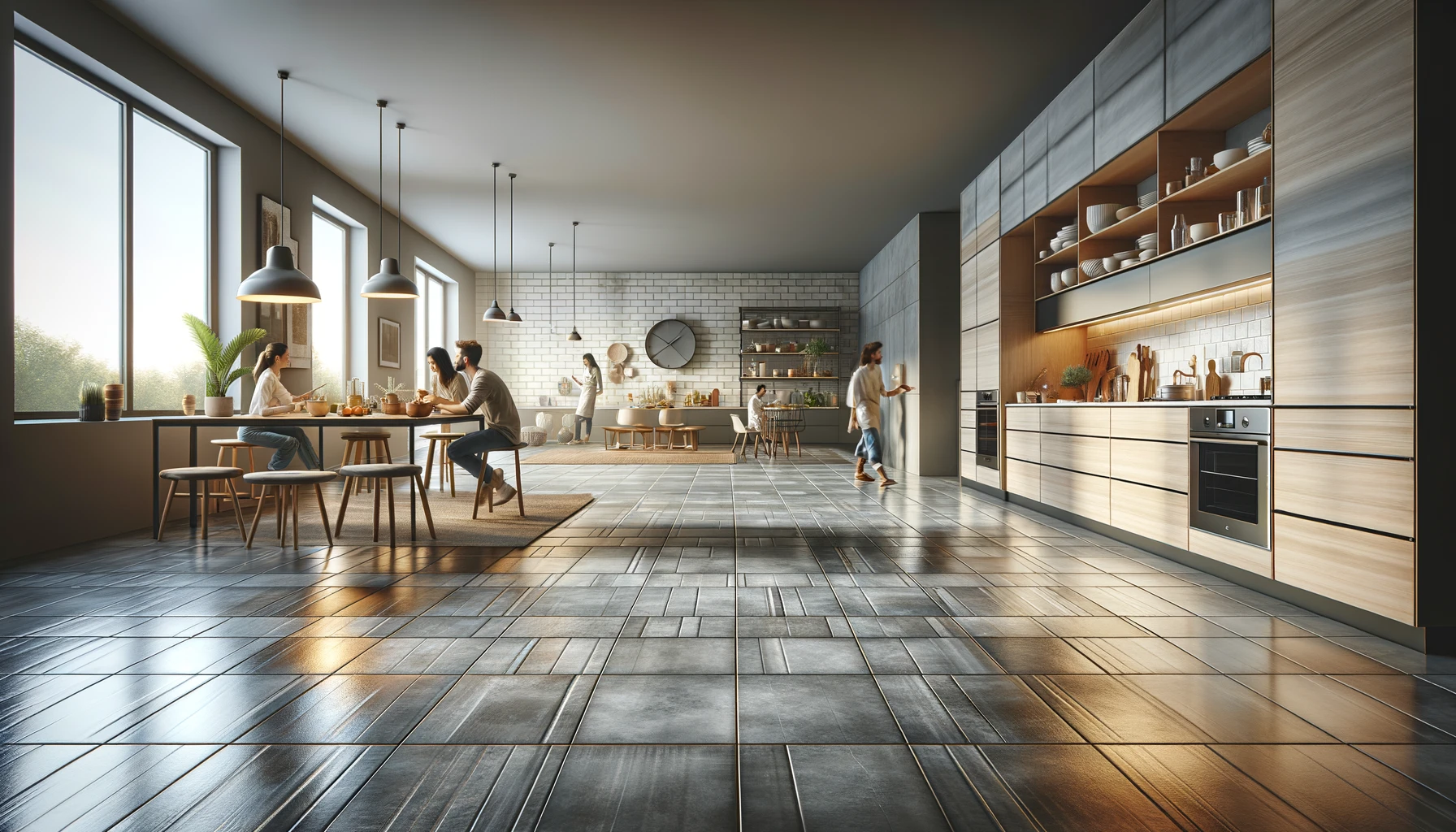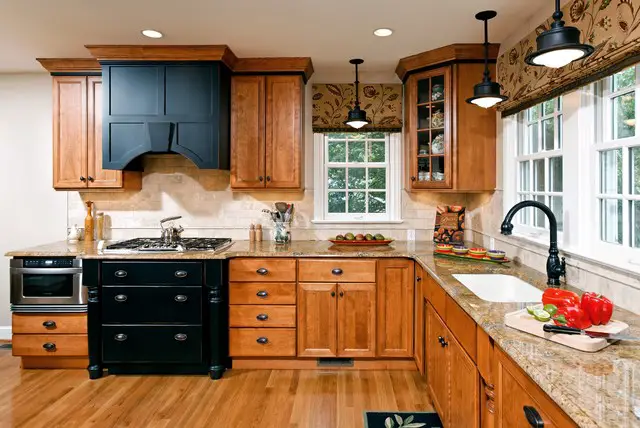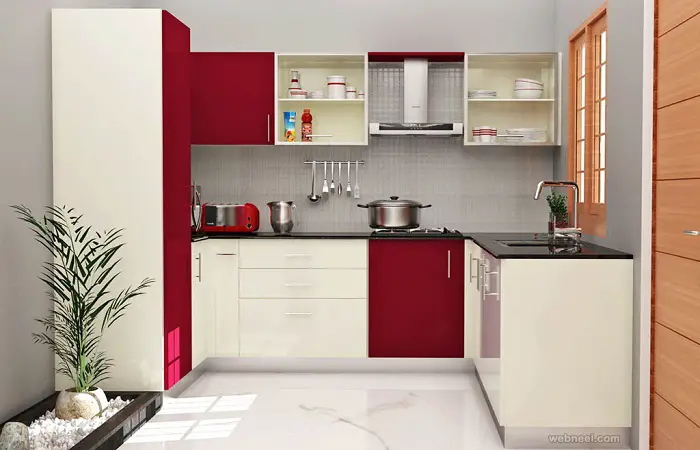Tired of spending hours scrubbing your kitchen floor? Say goodbye to the hassle of mopping and sweeping with easy-to-clean kitchen flooring options. Imagine a surface that effortlessly repels stains and spills, contrasting starkly with traditional flooring that demands relentless maintenance. Picture a kitchen floor that can handle the inevitable messes of everyday life without losing its luster – no more endless battles against stubborn grime.
Functionality is key. From durable flooring materials to sleek tiles, we’ll explore low-maintenance options designed to withstand the rigors of culinary chaos while still looking fabulous.
Key Takeaways
- Choose flooring options like vinyl, engineered wood, ceramic tile, or cork for easy cleaning and maintenance in the kitchen.
- Vinyl flooring offers the advantage of being water-resistant, durable, and easy to clean, making it a practical choice for busy kitchens.
- Engineered wood provides a low-maintenance alternative to traditional hardwood, offering both durability and easy cleaning.
- Ceramic tile is a popular choice due to its durability, stain resistance, and ease of maintenance, making it ideal for high-traffic kitchen areas.
- Cork flooring is a sustainable and comfortable option that is also easy to clean and maintain, providing a unique and eco-friendly choice for the kitchen.
- When selecting kitchen flooring, prioritize easy maintenance, durability, and water resistance to ensure a practical and long-lasting choice for your home.
Defining Easy-to-Clean Flooring
Durability is a key factor. These types of floors are resistant to wear and tear, making them ideal for withstanding heavy foot traffic in the kitchen. Resistance to heat and long-lasting, they can withstand the demands of a busy household.
For example, materials like porcelain tile or luxury vinyl flooring are known for their exceptional durability. Porcelain tile is highly resistant to scratches and stains, while luxury vinyl flooring offers excellent resilience against dents and scuffs. Their robust nature makes them perfect choices for kitchens where spills, dropped utensils, and high traffic are common occurrences.
Another aspect of durability is the ability of material easy-to-clean flooring options to maintain their appearance over time without extensive maintenance. This means that even after years of use, these floors continue to look as good as new with minimal effort on upkeep.
Popular Easy-to-Clean Flooring Options
Luxury Vinyl
Luxury vinyl is one of the most affordable and stylish flooring material options available. It effectively mimics the look of natural materials such as hardwood or stone, offering a high-end appearance without the hefty price tag. This type of flooring is also water-resistant, making it ideal for kitchens where spills are common. Cleaning luxury vinyl is a breeze, requiring only regular sweeping and occasional mopping with a mild cleaner.
Another advantage of luxury vinyl is its durability, which makes it suitable for high-traffic areas like kitchens. Its protective top layer, made of durable material, resists scratches, stains, and dents, ensuring that your kitchen floor maintains its pristine appearance for years to come.
Engineered Wood
Engineered wood provides the timeless beauty of real wood while being more resistant to warping and moisture compared to traditional hardwood floors. This makes it an excellent choice for kitchens where exposure to water and humidity is inevitable. With its low maintenance requirements, engineered wood stands out as an easy-to-clean flooring option.
To keep engineered wood flooring looking its best in the kitchen, simply sweep or vacuum regularly to remove debris that could scratch the surface. Wiping up spills promptly helps prevent any potential damage from liquid exposure to material.
Ceramic Tile
Ceramic tile boasts exceptional stain resistance and ease of cleaning in addition to being highly durable and long-lasting. The hard surface allows for quick wipe-downs with a damp cloth or mop when messes occur on this resilient flooring option.
With ceramic tile’s vast array of design options including different colors, patterns, shapes, sizes, and textures; you can effortlessly customize your kitchen floor according to your style preferences while enjoying hassle-free maintenance.
Cork Flooring
Cork flooring naturally repels mold and mildew due to its inherent properties—a beneficial feature particularly important in moisture-prone environments like kitchens. Beyond being easy on the feet due to its softness (making it comfortable for standing), cork flooring also offers simple cleaning solutions: just wipe clean with a damp cloth whenever necessary.
Advantages of Vinyl Flooring
Water Resistance
Vinyl flooring is highly resistant to water and spills, making it an ideal choice for kitchens. Its water-repelling properties protect against moisture damage that can occur in environments with high humidity levels or frequent liquid spills. This attribute makes vinyl flooring a practical and durable option for areas where maintaining cleanliness is essential. For instance, if a glass of water accidentally spills on the floor, you can simply wipe it off without worrying about long-term damage.
Furthermore, vinyl flooring’s ability to repel water ensures that it remains intact even when subjected to regular cleaning routines involving mopping or scrubbing. This resilience against moisture not only contributes to its longevity but also minimizes the risk of mold growth underneath the flooring surface.
Stain Resistance
In addition to being waterproof, vinyl flooring offers impressive stain resistance capabilities. It effectively resists stains from food and liquid spills, allowing for easy cleanup without leaving unsightly marks behind. Whether dealing with accidental wine spills during dinner preparation or dropped sauces while cooking, vinyl floors can be easily wiped clean using mild soap and water.
Moreover, this stain-resistant feature plays a crucial role in maintaining the fresh appearance of kitchen floors over time. The ease of cleaning prevents stubborn stains from setting into the material and keeps the surface looking new even after years of use. As a result, homeowners can enjoy beautiful kitchen spaces without constantly worrying about preserving their pristine condition.
Variety of Styles
One notable advantage of vinyl flooring is its versatility in terms of design options. With a wide range of colors and patterns available, homeowners have access to diverse styles that cater to various kitchen aesthetics. Whether seeking a sleek modern look or aiming for a more traditional feel, there are numerous design choices within the realm of vinyl flooring.
For example:
- Vinyl planks offer realistic wood visuals suitable for rustic-themed kitchens.
- Tile-patterned vinyl provides an elegant touch reminiscent of classic ceramic tiling.
- Solid-colored options allow for minimalist yet stylish appearances that complement contemporary kitchen designs.
This extensive variety empowers individuals to select vinyl floors that seamlessly integrate with their preferred interior styles while simultaneously benefiting from its easy-to-clean attributes.
Engineered Wood for Low Maintenance
Protective Finish
Engineered wood flooring is an excellent choice for those seeking easy-to-clean kitchen flooring options. Its protective finish acts as a barrier against scratches and scuffs, ensuring enhanced durability and longevity. This means you won’t have to worry about frequent repairs or replacements, saving both time and money in the long run. With its easy maintenance requirements, all it takes is regular cleaning to keep your engineered wood kitchen floor looking pristine.
The protective finish of engineered wood makes it resistant to daily wear and tear, making it an ideal option for high-traffic areas like the kitchen. Whether it’s spills from cooking or foot traffic from family members, this type of flooring can withstand the challenges of everyday use without losing its luster. By choosing engineered wood with a protective finish, homeowners can enjoy the beauty of hardwood floors without the extensive upkeep typically associated with them.
Easy Repair
When accidents happen and individual tiles or planks get damaged, repairing engineered wood flooring is a breeze. Unlike traditional hardwood floors that may require extensive effort to fix, replacing individual pieces of engineered wood involves minimal time and labor. This makes it an attractive choice for busy households where convenience is key.
Moreover, easy repair translates into cost savings over time. Instead of having to replace entire sections due to damage, homeowners can simply swap out the affected tiles or planks without disrupting their entire kitchen space. This not only saves money on maintenance but also ensures that any repairs are completed with minimal effort.
Ceramic Tile Benefits
Longevity
Ceramic tiles are renowned for their longevity. Made from durable materials, they are designed to withstand the wear and tear of daily use. In high traffic areas such as the kitchen, ceramic tiles stand the test of time, requiring minimal replacement over the years. This makes them a cost-effective option for homeowners looking for flooring that will last.
The durability of ceramic tiles is ideal for busy kitchens where spills and heavy foot traffic are common occurrences. Unlike other flooring options that may show signs of wear and tear over time, ceramic tiles maintain their appearance and structural integrity even in demanding environments. For homeowners seeking a low-maintenance yet long-lasting solution for their kitchen flooring, ceramic tiles offer an attractive choice.
Hygiene Factor
In addition to their longevity, another significant benefit of ceramic tile is its hygienic properties. The smooth surface of ceramic tiles makes them easy to clean, minimizing bacteria buildup in the kitchen environment. With regular cleaning using simple household products or mild detergents, ceramic tile floors can be kept free from germs and contaminants.
Unlike some other flooring materials that can harbor bacteria or mold if not properly maintained, ceramic tiles provide a sanitary surface that promotes a healthy kitchen environment. This feature is especially important for households with children or individuals with allergies or respiratory sensitivities who require clean living spaces.
Cork Flooring Advantages
Natural Resistance
Cork flooring is naturally resistant to moisture and stains, making it an ideal choice for kitchen floors. Its inherent properties make it less susceptible to damage from everyday use, ensuring that it maintains its integrity over time. This means that spills and splashes in the kitchen are not a major concern with cork flooring. Unlike other materials, cork doesn’t absorb liquids easily, preventing staining and warping.
Moreover, the durability of cork makes it a practical option for kitchens where heavy foot traffic is common. The material’s ability to withstand wear and tear means that homeowners can enjoy long-lasting flooring without having to worry about frequent maintenance or replacement costs.
Comfort and Warmth
One of the standout features of cork flooring is its ability to provide comfort and warmth in the kitchen environment. Due to its cellular structure, cork has natural insulating properties which make it warm underfoot. This added warmth creates a cozy atmosphere in the kitchen, making it an inviting space for cooking and socializing.
The cushioned surface of cork reduces fatigue during cooking activities by providing a soft yet supportive foundation for standing on while working in the kitchen. This feature can be especially beneficial for individuals who spend extended periods preparing meals or engaging in various culinary tasks within their kitchens.
Selecting the Right Kitchen Flooring
Lifestyle Considerations
When choosing kitchen flooring, it’s crucial to consider your lifestyle. Look for options that suit various needs, such as accommodating pets, children, and high traffic. For busy households, opt for materials that fit well with your routines.
For instance, easy-to-clean kitchen flooring options like vinyl or laminate are perfect for families with kids and pets. These materials offer durability and simple maintenance while standing up to the demands of a bustling household.
Budget Constraints
Considering budget constraints is essential when selecting kitchen flooring. You can find affordable options suitable for different budgets without compromising quality. This means you can save money on both installation and long-term maintenance costs.
For example, laminate flooring provides a cost-effective solution that mimics the look of hardwood or tile without breaking the bank. It’s durable, easy to install, and requires minimal upkeep—ideal for those looking to save on expenses while still achieving an attractive kitchen floor.
Installation Options
Exploring different installation methods is also vital in determining the right kitchen flooring option for your home. Look for versatile installation techniques that cater to various preferences—whether you’re considering a DIY project or professional installation services.
Take vinyl plank flooring as an example; this material offers flexibility in terms of installation since it can be installed using either click-and-lock or peel-and-stick methods. This makes it suitable for homeowners who prefer to take on projects themselves while ensuring a seamless finish regardless of their kitchen layout.
Avoiding High-Maintenance Flooring
Carpet Concerns
Avoiding potential issues with carpet is crucial. Carpet in the kitchen can lead to concerns about spills, stains, and odors. By choosing a different type of flooring, you can maintain a cleaner and more hygienic kitchen space. For instance, opting for durable flooring such as vinyl or laminate can provide an easy-to-clean alternative to carpet.
These alternatives offer a wide range of design options that mimic the look of hardwood or tile without the maintenance challenges associated with those materials. With easy-to-clean flooring, you won’t have to worry about deep cleaning carpets regularly or dealing with lingering odors from food spills.
Hardwood Challenges Another essential aspect when considering easy-to-clean kitchen flooring options is bypassing common hardwood challenges in kitchens. Traditional hardwood floors are prone to warping, scratching, and water damage issues when used in the kitchen. Choosing new floors like luxury vinyl planks or porcelain tile presents an easier-to-maintain alternative to traditional hardwood.
Luxury vinyl planks are designed to withstand heavy foot traffic and resist scratches and moisture—ideal for busy kitchens where spills are common occurrences. On the other hand, porcelain tile offers durability against water exposure while providing limitless design possibilities through various colors and patterns.
Economic and Durable Choices
Cost-Effective Materials
There are several cost-effective materials that offer both practicality and style. Vinyl is a great choice for budget-conscious homeowners as it provides durability, water resistance, and easy maintenance. It’s available in a wide range of designs, including options that mimic the look of natural materials like wood or stone. Another good choice is laminate flooring, which offers similar benefits to vinyl but at an even more affordable price point. These materials are not only easy to clean but also provide long-term value by withstanding heavy foot traffic and daily wear and tear.
For those seeking a budget-friendly yet stylish option, linoleum stands out as another great choice for kitchen flooring. Linoleum is made from natural materials such as linseed oil, cork dust, wood flour, tree resins, and ground limestone. This eco-friendly material is not only durable but also resistant to stains and easy to maintain. Its longevity makes it a good investment for homeowners looking for an economical yet reliable flooring solution.
Long-Term Value
In addition to being cost-effective upfront choices, these easy-to-clean kitchen flooring options offer long-term value due to their durability and low maintenance requirements. Vinyl’s ability to resist moisture makes it suitable for areas prone to spills or high humidity levels like kitchens or bathrooms. Its protective top layer helps prevent scratches and stains while requiring minimal effort when cleaning up messes.
Similarly, laminate flooring’s tough outer layer makes it highly resilient against scratches, dents, fading caused by sunlight exposure – making it ideal for busy households with pets or children who tend to cause accidental damage over time. Moreover its simple click-and-lock installation system allows homeowners on tight budgets save money on professional installation fees.
Linoleum’s resilience against wear ensures that it maintains its attractive appearance without extensive upkeep efforts required over the years – giving homeowners peace of mind knowing they have made a wise investment in their home’s future.
By carefully considering these economic yet durable choices when selecting your kitchen flooring material you can ensure you get the best bang for your buck while keeping your space looking pristine day after day.
Final Remarks
You’ve now got the lowdown on easy-to-clean kitchen flooring options. From the resilience of vinyl to the timeless appeal of ceramic tiles, and the eco-friendly charm of cork, you’re armed with the knowledge to make a savvy choice. Remember, your kitchen floor takes a beating, so opt for something that can roll with the punches without demanding too much TLC. It’s all about finding that sweet spot between style and practicality. So, go ahead, weigh your options, consider your lifestyle, and pick a flooring that fits like a glove in your kitchen.
Now that you’re in the know about easy-to-clean kitchen flooring, it’s time to roll up your sleeves and start exploring your options. Don’t rush this decision; take the time to find the perfect balance between functionality and aesthetics. Your kitchen floor plays a crucial role in your home, so make sure it’s up to the task.
Frequently Asked Questions
What are the characteristics of easy-to-clean flooring?
Easy-to-clean flooring is typically water-resistant, stain-resistant, and durable. It requires minimal maintenance and can withstand regular cleaning without damage.
Is vinyl flooring a good option for easy cleaning?
Yes, vinyl flooring is an excellent choice for easy cleaning due to its water resistance and simple maintenance requirements. It’s also durable and available in various styles.
How does ceramic tile benefit kitchen spaces?
Ceramic tiles are advantageous in kitchens as they are moisture-resistant, easy to clean, and offer a wide range of design options to match different kitchen aesthetics.
Why is engineered wood recommended for low maintenance?
Engineered wood is ideal for low maintenance because it provides the aesthetic appeal of hardwood but with enhanced durability and easier upkeep.
What should I consider when selecting the right kitchen flooring?
Consider factors such as ease of cleaning, durability, water resistance, and your personal style preferences when choosing the right kitchen flooring. Each type has its own benefits that cater to different needs.
Are there any economic yet durable choices for kitchen flooring?
Yes, options like vinyl plank or laminate provide cost-effective solutions while offering durability suitable for high-traffic areas like the kitchen. These materials can mimic the look of natural materials at a lower cost.






